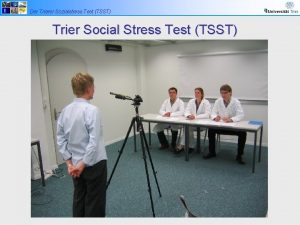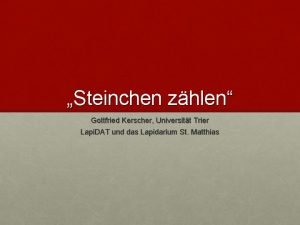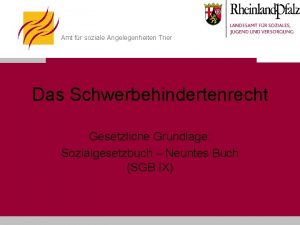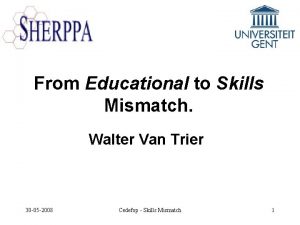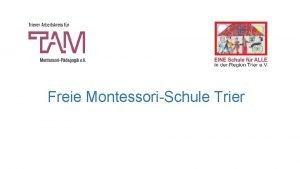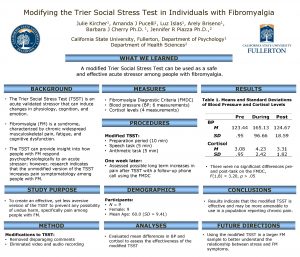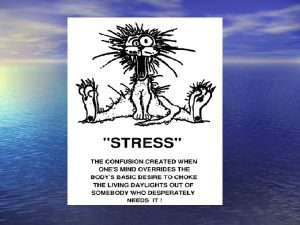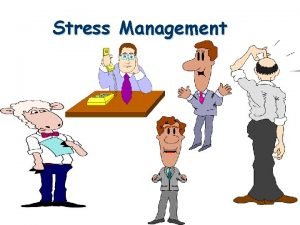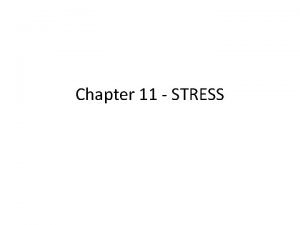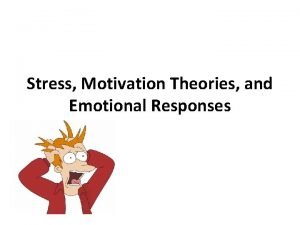Der Trierer Sozialstress Test TSST Trier Social Stress











- Slides: 11

Der Trierer Sozialstress Test (TSST) Trier Social Stress Test (TSST)

Der Trierer Sozialstress Test (TSST) Based on the ‘Mason’ factors (1968 Psychosom Med) § A situation is perceived as stressful if it contains… § novelty § unpredictability § uncontrollability § ambiguity § anticipation (of negative consequences) § ego-involvement § Recent metaanalysis (Dickerson & Keneny 2004 Psychol Bull) § situations inducing HPA axis responses do often combine Uncontrollability and Social-Evaluative Threat

Der Trierer Sozialstress Test (TSST) § Meanwhile well over 4. 000 TSST sessions performed world-wide (for recent reviews see Kudielka et al. , 2007 a, 2007 b) § TSST versions for children and older adults § healthy populations § patients (psychiatric disorders, CFS, PTSD, pain, immunological disorders, etc. ) § Studies on effects of: § age, gender, sex hormones § genetics, polymorphisms § social support, social hierachy § personality factors § intervention / stress management training § oxytocin, pregnancy, lactation & breast-feeding § nicotine, alcohol & coffee consumption, food/dietary energy supplies § medication (psychoactive drugs, aspirin, beta-blocker etc. ) § habituation § […]

Der Trierer Sozialstress Test (TSST) Only a very few findings with TSST …

Der Trierer Sozialstress Test (TSST) Kudielka et al. (1998) Journal of Clinical Endocrinology & Metabolism Kudielka et al. (2004) Psychoneuroendocrinology Do men and women show different stress responses? Yes ! Role of menstrual cycle phase: Kirschbaum, Kudielka et al. (1999) Psychosomatic Medicine

Der Trierer Sozialstress Test (TSST) Role of menstrual cycle phase Kirschbaum, Kudielka et al. (1999) Psychosomatic Medicine

Der Trierer Sozialstress Test (TSST) Age effects TSST: No DEX-CRH-Feedback-Test: Yes Kudielka et al. (2004) Psychoneuroendocrinology older men (n=15) older women (N=15) Younger men (n=12) 10 8 6 14 Free Salivary Cortisol (nmol/l) 12 100 µg h. CRH Free Salivary Cortisol (nmol/l) Dex-premedication 4 2 Dex-premedication 12 10 8 6 100 µg h. CRH younger women (N=15) 14 4 2 0 0 0 20 40 60 80 100 120 Time (min) Kudielka et al. (1999) Neuroendocrinology 0 20 40 60 80 100 Time (min) Kudielka et al. (2000) Stress 120

Der Trierer Sozialstress Test (TSST) Methodological aspects: time of day increase area under the curve Kudielka et al. (2004) Psychoneuroendocrinology

Der Trierer Sozialstress Test (TSST) § Variables that show increases after the TSST § salivary free cortisol (2 -3 fold rise in about 70 -80% of subjects) § total plasma cortisol, ACTH § adrenaline, noradrenaline, growth hormone, prolactin, testosterone § blood pressure, heart rate, α-amylase § immune parameters (e. g. , lymphocytes, IL-6, TNF-α) § blood coagulation markers (e. g. , fibrinogen, D-dimer, v. WF, clotting factors) § measures of hemoconcentration (e. g. , hematocrit, haemoglobin, plasma volume) § endogenous inhibitor of monoamine oxidase (MAO-AI) § […] § altered well-being, pain sensitivity, alcohol consumption, drug effects etc.

Der Trierer Sozialstress Test (TSST) Final Remarks § Identifying the determinants of HPA axis regulation and dysregulation is, particularly in humans, a very challenging task. § An extensive phenotyping with markers of basal as well as stimulated HPA axis activity is required in order § to elucidate the mechanisms mediating stress related disorders and § to develop new therapeutic strategies

Der Trierer Sozialstress Test (TSST) Future Challenges § § § What is a normal range? huge interindividual variability HPA axis = highly adaptive system many aspects not directly observable in humans (brain, earlier adaptive processes) sensitivity of target tissue low correlation across tests cortisol level is not a stable attribute of a subject influenced by situational factors extent to which trait components can be detected depends significantly on the quality of the used measures
